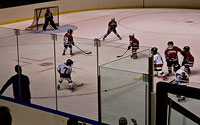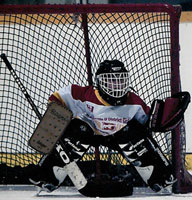"If you want to understand today, you have to search yesterday."
~Pearl Buck
Women and girls have taken to ice hockey in unprecedented numbers since the early 1990s. Female leagues and co-ed programs have changed the face of the game in many communities, and elite women's hockey has emerged as an intercollegiate and Olympic sport. However, despite the recent growth in women’s hockey participation, women have been playing hockey for over a century now. In fact, the Canadian Hockey Association says the first recorded women's hockey game took place in 1892 in Barrie, Ontario. Another account by "Total Hockey," the official encyclopedia of the NHL, places the first game in Ottawa,  where the Government House team defeated the Rideau ladies team in 1889. By the turn of the century, women's hockey teams were playing all across Canada. The standard uniforms at this included long wool skirts, turtleneck sweaters, hats and gloves, which can be determined by looking at photos of women’s hockey players at that time (Fitzpatrick).
where the Government House team defeated the Rideau ladies team in 1889. By the turn of the century, women's hockey teams were playing all across Canada. The standard uniforms at this included long wool skirts, turtleneck sweaters, hats and gloves, which can be determined by looking at photos of women’s hockey players at that time (Fitzpatrick).
This first era of women's hockey peaked in the 1920s and 1930s, with teams, leagues, and tournaments in almost every region of Canada and a few areas of the United States. Some of the best Canadian teams met annually in an East-West tournament to declare a national champion. Unfortunately, the popularity of women's hockey started to decline in the 1930s and 1940s, mostly because of the demands of the Depression and World War II. However, those rather dark years did produce one of the greatest women's hockey teams of all time: the Preston Rivulettes, who lost only twice in 350 Canadian league games during a stretch from 1930 to 1939 organized. By the 1950s and 1960s, women's hockey became regarded as little more than a curiosity. Hockey was assumed to be for the preservation of men and boys, an attitude confirmed in 1956 when the Ontario Supreme Court ruled against Abby Hoffman, a nine-year-old girl who challenged the "boys only" policy in minor hockey (Fitzpatrick). Hoffman had already played most of the season with a boy's team, disguising her sex by dressing at home and wearing her hair short.
A revival of women’s hockey began in the 1960s. Most girls attempting to join boy’s teams were still rejected. However, women's hockey slowly gained ice time, and as the new generation of players grew up, they demanded a chance to play at colleges and universities (Fitzpatrick). Canadian intercollegiate women's hockey began in the 1980s and the NCAA recognized the game in 1993.
time, and as the new generation of players grew up, they demanded a chance to play at colleges and universities (Fitzpatrick). Canadian intercollegiate women's hockey began in the 1980s and the NCAA recognized the game in 1993.
An international breakthrough came in 1990, when eight countries contested in the first Women's World Ice Hockey Championship. Participation grew exponentially in the decade that followed. Women's hockey made its Olympic debut at the 1998 Games in Japan. In 2002, the Mission Betty's of California became the first all-girls team to enter the Quebec International Pee Wee Tournament, one of the world's largest youth competitions (Fitzpatrick).
Today the number of female hockey teams and leagues is at an all-time high. Mixed gender teams are also more common, especially in youth hockey. The game remains a male-dominated culture, but girls and women face much less of the obstruction and prejudice that frustrated their predecessors (Fitzpatrick).
The National Women's Hockey League began in 2000, giving top female athletes a chance to play outside the college or international systems. The Western Women's Hockey League was established in 2004 for the same purpose as the National Women’s Hockey League.
1956: Abby Hoffman at the age of nine was able to join a boy's hockey team as Ab by cutting her hair and dressing at home to pass herself off as a boy. Her team did so well that they made it to the playoffs where players were required to produce their birth certificates. When it was discovered that Ab was really Abigail, the league was outraged. Young Abigail was forced to resign from hockey following the end of the season.
Sept. 23, 1992: Manon Rheaume makes history when she steps onto NHL ice at age 20. She becomes the first woman to play professional hockey. The native Quebecer plays net for the Tampa Bay Lightning as part of an exhibition game against the St. Louis Blues. She played for one period facing a total of nine shots and documenting seven saves and two goals against.
2003: Hayley Wickenheiser makes history by becoming the first woman ever to register a point in a men's pro hockey game.
2002 - Won Gold Medal
2006 - Won Gold Medal
1992 - Won Gold Medal
1994 - Won Gold Medal
1997 - Won Gold Medal
1999 - Won Gold Medal
2000 - Won Gold Medal
2001 - Won Gold Medal
2004 - Won Gold Medal
2005 - Won Silver Medal
2007 - Won Gold Medal
2008 - Won Silver Medal
2009 - Won Silver Medal
"Fair Game: Pioneering Canadian Women in Sports |." CBC Archives. 14 Nov. 1992. 11 May 2009
"Canada women's national ice hockey team -." Wikipedia, the free encyclopedia. 11 May 2009